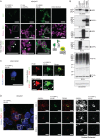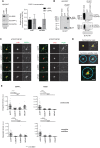The E3 ubiquitin ligase UBR5 regulates centriolar satellite stability and primary cilia
- PMID: 29742019
- PMCID: PMC6080653
- DOI: 10.1091/mbc.E17-04-0248
The E3 ubiquitin ligase UBR5 regulates centriolar satellite stability and primary cilia
Erratum in
-
Correction.Mol Biol Cell. 2022 Feb 1;33(2):cor1. doi: 10.1091/mbc.E17-04-0248-corr. Mol Biol Cell. 2022. PMID: 35041470 Free PMC article. No abstract available.
Abstract
Primary cilia are crucial for signal transduction in a variety of pathways, including hedgehog and Wnt. Disruption of primary cilia formation (ciliogenesis) is linked to numerous developmental disorders (known as ciliopathies) and diseases, including cancer. The ubiquitin-proteasome system (UPS) component UBR5 was previously identified as a putative positive regulator of ciliogenesis in a functional genomics screen. UBR5 is an E3 ubiquitin ligase that is frequently deregulated in tumors, but its biological role in cancer is largely uncharacterized, partly due to a lack of understanding of interacting proteins and pathways. We validated the effect of UBR5 depletion on primary cilia formation using a robust model of ciliogenesis, and identified CSPP1, a centrosomal and ciliary protein required for cilia formation, as a UBR5-interacting protein. We show that UBR5 ubiquitylates CSPP1, and that UBR5 is required for cytoplasmic organization of CSPP1-comprising centriolar satellites in centrosomal periphery, suggesting that UBR5-mediated ubiquitylation of CSPP1 or associated centriolar satellite constituents is one underlying requirement for cilia expression. Hence, we have established a key role for UBR5 in ciliogenesis that may have important implications in understanding cancer pathophysiology.
Figures






Similar articles
-
Tethering of an E3 ligase by PCM1 regulates the abundance of centrosomal KIAA0586/Talpid3 and promotes ciliogenesis.Elife. 2016 May 5;5:e12950. doi: 10.7554/eLife.12950. Elife. 2016. PMID: 27146717 Free PMC article.
-
EHD1 promotes CP110 ubiquitination by centriolar satellite delivery of HERC2 to the mother centriole.EMBO Rep. 2023 Jun 5;24(6):e56317. doi: 10.15252/embr.202256317. Epub 2023 Apr 19. EMBO Rep. 2023. PMID: 37074924 Free PMC article.
-
CYLD Regulates Centriolar Satellites Proteostasis by Counteracting the E3 Ligase MIB1.Cell Rep. 2019 May 7;27(6):1657-1665.e4. doi: 10.1016/j.celrep.2019.04.036. Cell Rep. 2019. PMID: 31067453
-
Regulation of primary cilia formation by the ubiquitin-proteasome system.Biochem Soc Trans. 2016 Oct 15;44(5):1265-1271. doi: 10.1042/BST20160174. Biochem Soc Trans. 2016. PMID: 27911708 Review.
-
Functional Roles of the E3 Ubiquitin Ligase UBR5 in Cancer.Mol Cancer Res. 2015 Dec;13(12):1523-32. doi: 10.1158/1541-7786.MCR-15-0383. Epub 2015 Oct 13. Mol Cancer Res. 2015. PMID: 26464214 Review.
Cited by
-
HnRNP-L-regulated circCSPP1/miR-520h/EGR1 axis modulates autophagy and promotes progression in prostate cancer.Mol Ther Nucleic Acids. 2021 Oct 19;26:927-944. doi: 10.1016/j.omtn.2021.10.006. eCollection 2021 Dec 3. Mol Ther Nucleic Acids. 2021. PMID: 34760337 Free PMC article.
-
Primary Cilia Reconsidered in the Context of Ciliopathies: Extraciliary and Ciliary Functions of Cilia Proteins Converge on a Polarity theme?Bioessays. 2018 Aug;40(8):e1700132. doi: 10.1002/bies.201700132. Epub 2018 Jun 8. Bioessays. 2018. PMID: 29882973 Free PMC article. Review.
-
Centriolar satellites are acentriolar assemblies of centrosomal proteins.EMBO J. 2019 Jul 15;38(14):e101082. doi: 10.15252/embj.2018101082. Epub 2019 Jun 3. EMBO J. 2019. PMID: 31304626 Free PMC article.
-
A CEP104-CSPP1 Complex Is Required for Formation of Primary Cilia Competent in Hedgehog Signaling.Cell Rep. 2019 Aug 13;28(7):1907-1922.e6. doi: 10.1016/j.celrep.2019.07.025. Cell Rep. 2019. PMID: 31412255 Free PMC article.
-
CSPP1 stabilizes growing microtubule ends and damaged lattices from the luminal side.J Cell Biol. 2023 Apr 3;222(4):e202208062. doi: 10.1083/jcb.202208062. Epub 2023 Feb 8. J Cell Biol. 2023. PMID: 36752787 Free PMC article.
References
-
- Bjellqvist B, Hughes GJ, Pasquali C, Paquet N, Ravier F, Sanchez JC, Frutiger S, Hochstrasser D. (1993). The focusing positions of polypeptides in immobilized pH gradients can be predicted from their amino acid sequences. Electrophoresis , 1023–1031. - PubMed
Publication types
MeSH terms
Substances
LinkOut - more resources
Full Text Sources
Other Literature Sources
Research Materials

